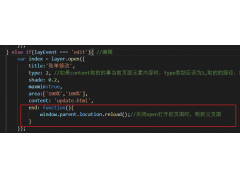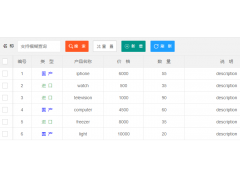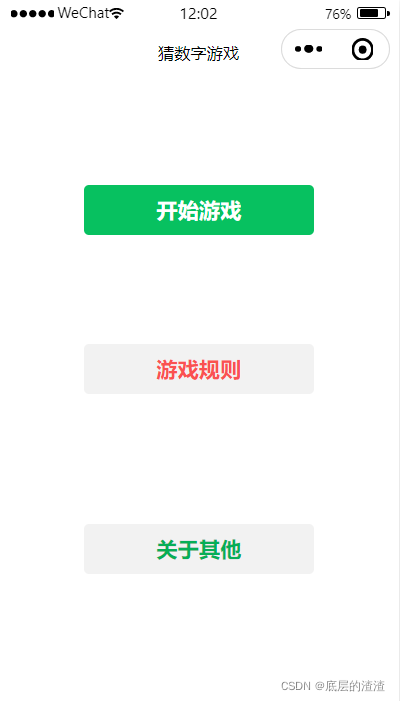R Shiny + plotly : change color of a trace with javascript without affecting markers and legend in multiple plots(R Shiny + plotly:使用 javascript 更改轨迹的颜色,而不影响多个图中的标记和图例)
问题描述
This is a follow up question based on THIS post.
The demo app here is a closer representation of my more complex situation of my real shiny app that I'm trying to improve by replacing code that causes re-rendering of plotly objects by javascript codes that alter the existing plots.
This app has:
- 4 plots with unique ID's
- sets of 2 plots listen to the same set of colourInputs, 1 for each trace in each plot
- the legend and marker size in all plots are linked to numericInputs
The modification of the javascript from the previous question for this solution would need to:
- follow the size inputs
- follow the trace - colourInput linking
- target trace n in 2 plots based on colourInput n belonging to those 2 plots.
EDIT: slightly simplified scenario Lets drop the legend issue for now, since the solution part 2 by Stephane does what I want for the colors. I'll deal with the legend sizing later.
The modified version might be a little clearer.
The javascript should:
if plot id is "plot1" or "plot2" listen to color-set1-1 till -3
if plot id is 'plot3' or 'plot4', lister to color-set2-1 till -3
I suppose we need some to add some lines in the js like: "
"var setnr = parseInt(id.split('-')[1]) ;",
to see which set of buttons we are looking at, followed by an if statement that achieves:
if 'setnr' == set1 , then var plots = plot1, plot2
else if 'setnr == set2, then var plots = plot3, plot4
and then update the trace in 'plots'
In the new app, the color-set1-1, color-set1-2, color-set1-3 still target all 4 plots.
library(plotly)
library(shiny)
library(colourpicker)
library(htmlwidgets)
js <- c(
"function(el,x){",
" $('[id^=Color]').on('change', function(){",
" var color = this.value;",
" var id = this.id;",
" var index = parseInt(id.split('-')[1]) - 1;",
" var data = el.data;",
" var marker = data[index].marker;",
" marker.color = color;",
" Plotly.restyle(el, {marker: marker}, [index]);",
" });",
"}")
ui <- fluidPage(
fluidRow(
column(4,plotlyOutput("plot1")),
column(4,plotlyOutput("plot2")),
column(4,
colourInput("Color-1", "Color item 1", value = "blue"), # these buttons will become named Color-set1-1, Color-set1-2, Color-set1-3
colourInput("Color-2", "Color item 2", value = "red"), # but that requires an extra change to the js
colourInput("Color-3", "Color item 3", value = "green")
)
),
fluidRow(
column(4,plotlyOutput("plot3")),
column(4,plotlyOutput("plot4")),
column(4,
colourInput("Color-set2-1", "Color item 1", value = "blue"),
colourInput("Color-set2-2", "Color item 2", value = "red"),
colourInput("Color-set2-3", "Color item 3", value = "green")
)
)
)
server <- function(input, output, session) {
values <- reactiveValues(colors1 = c('red', 'blue', 'black'), colors2 = c('yellow', 'blue', 'green') )
myplotly <- function(THEPLOT, xvar, setnr) {
markersize <- input[[paste('markersize', THEPLOT, sep = '_')]]
markerlegendsize <- input[[paste('legendsize', THEPLOT, sep = '_')]]
colors <- isolate ({values[[paste('colors', setnr, sep = '')]] })
p <- plot_ly(source = paste('plotlyplot', THEPLOT, sep = '.'))
p <- add_trace(p, data = mtcars, x = mtcars[[xvar]], y = ~mpg, type = 'scatter', mode = 'markers', color = ~as.factor(cyl), colors = colors)
p <- layout(p, title = 'mtcars group by cyl with switching colors')
p <- plotly_build(p)
p %>% onRender(js)
}
output$plot1 <- renderPlotly({ myplotly('plot1', 'hp', 1) })
output$plot2 <- renderPlotly({ myplotly('plot2', 'disp', 1)})
output$plot3 <- renderPlotly({ myplotly('plot3','hp', 2)})
output$plot4 <- renderPlotly({ myplotly('plot4', 'disp', 2)})
}
shinyApp(ui, server)
The original APP:
library(plotly)
library(shiny)
library(htmlwidgets)
library(colourpicker)
library(shinyjs)
## javascript from previous question's answer:
jsCode <- "shinyjs.changelegend = function(){
var paths = d3.select('#plot1').
select('.legend').
select('.scrollbox').
selectAll('.traces').
select('.scatterpts')
.attr('d','M8,0A8,8 0 1,1 0,-8A8,8 0 0,1 8,0Z');}"
ui <- fluidPage(
tags$script(src = "https://d3js.org/d3.v4.min.js"),
useShinyjs(),
extendShinyjs(text = jsCode),
fluidRow(
column(2,numericInput(inputId = 'markersize_plot1', label = 'marker', min = 1, max = 40, value = 20)),
column(2,numericInput(inputId = 'legendsize_plot1', label = 'legend', min = 1, max = 40, value = 10)),
column(2,numericInput(inputId = 'markersize_plot2', label = 'marker', min = 1, max = 40, value = 4)),
column(2,numericInput(inputId = 'legendsize_plot2', label = 'legend', min = 1, max = 40, value = 20))
),
fluidRow(
column(4,plotlyOutput("plot1")),
column(4,plotlyOutput("plot2")),
column(2,uiOutput('buttons_color_1'))
),
fluidRow(
column(2,numericInput(inputId = 'markersize_plot3', label = 'marker', min = 1, max = 40, value = 10)),
column(2,numericInput(inputId = 'legendsize_plot3', label = 'legend', min = 1, max = 40, value = 30)),
column(2,numericInput(inputId = 'markersize_plot4', label = 'marker', min = 1, max = 40, value = 7)),
column(2,numericInput(inputId = 'legendsize_plot4', label = 'legend', min = 1, max = 40, value = 40))
),
fluidRow(
column(4,plotlyOutput("plot3")),
column(4,plotlyOutput("plot4")),
column(2,uiOutput('buttons_color_2'))
)
)
server <- function(input, output, session) {
values <- reactiveValues(colors1 = c('red', 'blue', 'black'), colors2 = c('yellow', 'blue', 'green') )
lapply(c(1:2), function(i) {
output[[paste('buttons_color_', i,sep = '')]] <- renderUI({
isolate({ lapply(1:3, function(x) { ## 3 in my app changes based on clustering output of my model
Idname <- if(i == 1) { COLElement_1(x) } else {COLElement_2(x) }
div(colourpicker::colourInput(inputId = Idname, label = NULL,
palette = "limited", allowedCols = TheColors,
value = values[[paste('colors', i, sep = '')]][x],
showColour = "background", returnName = TRUE),
style = " height: 30px; width: 30px; border-radius: 6px; border-width: 2px; text-align:center; padding: 0px; display:block; margin: 10px")
})
})})
outputOptions(output, paste('buttons_color_', i,sep = ''), suspendWhenHidden=FALSE)
})
COLElement_1 <- function(idx){sprintf("COL_button_1-%d",idx)}
lapply(1:3, function(ob) {
COLElement_1 <- COLElement_1(ob)
observeEvent(input[[COLElement_1]], {
values[[paste('colors', 1, sep = '')]][ob] <- input[[COLElement_1]]
plotlyProxy("plot1", session) %>%
plotlyProxyInvoke("restyle", list(marker = list(color = input[[COLElement_1]])), list(as.numeric(ob)-1))
plotlyProxy("plot2", session) %>%
plotlyProxyInvoke("restyle", list(marker = list(color = input[[COLElement_1]])), list(as.numeric(ob)-1))
})
})
COLElement_2 <- function(idx){sprintf("COL_button_2-%d",idx)}
lapply(1:3, function(ob) {
COLElement_2 <- COLElement_2(ob)
observeEvent(input[[COLElement_2]], {
values[[paste('colors', 2, sep = '')]][ob] <- input[[COLElement_2]]
plotlyProxy("plot3", session) %>%
plotlyProxyInvoke("restyle", list(marker = list(color = input[[COLElement_2]])), list(as.numeric(ob)-1))
plotlyProxy("plot4", session) %>%
plotlyProxyInvoke("restyle", list(marker = list(color = input[[COLElement_2]])), list(as.numeric(ob)-1))
})
})
myplotly <- function(THEPLOT, xvar, setnr) {
markersize <- input[[paste('markersize', THEPLOT, sep = '_')]]
markerlegendsize <- input[[paste('legendsize', THEPLOT, sep = '_')]]
colors <- isolate ({values[[paste('colors', setnr, sep = '')]] })
p <- plot_ly(source = paste('plotlyplot', THEPLOT, sep = '.'))
p <- add_trace(p, data = mtcars, x = mtcars[[xvar]], y = ~mpg, type = 'scatter', mode = 'markers', color = ~as.factor(cyl), colors = colors)
p <- layout(p, title = 'mtcars group by cyl with switching colors')
p <- plotly_build(p)
# this is a bit of a hack to change the size of the legend markers to not be equal to the plot marker size.
# it makes a list of 1 size value for each marker in de trace in the plot, and another half of with sizes that are a lot bigger.
# the legend marker size is effectively the average size of all markers of a trace
for(i in seq(1, length(sort(unique(mtcars$cyl) )))) {
length.group <- nrow(mtcars[which(mtcars$cyl == sort(unique(mtcars$cyl))[i]), ])
p$x$data[[i]]$marker$size <- c(rep(markersize,length.group), rep(c(-markersize+2*markerlegendsize), length.group))
}
p
}
output$plot1 <- renderPlotly({ myplotly('plot1', 'hp', 1) })
output$plot2 <- renderPlotly({ myplotly('plot2', 'disp', 1)})
output$plot3 <- renderPlotly({ myplotly('plot3','hp', 2)})
output$plot4 <- renderPlotly({ myplotly('plot4', 'disp', 2)})
}
shinyApp(ui, server)
I'm lost :) Let's start. Here is an app allowing to change the marker size:
library(plotly)
library(shiny)
js <- paste(c(
"$(document).ready(function(){",
" $('#size').on('change', function(){",
" var size = Number(this.value);",
" var plot = document.getElementById('plot');",
" var data = plot.data;",
" $.each(data, function(index,value){",
" var marker = data[index].marker;",
" marker.size = size;",
" Plotly.restyle(plot, {marker: marker}, [index]);",
" });",
" });",
"})"), sep = "
")
ui <- fluidPage(
tags$head(
tags$script(HTML(js))
),
plotlyOutput("plot"),
numericInput("size", "Size", value = 5, min = 1, max = 15)
)
server <- function(input, output, session) {
output$plot <- renderPlotly({
p <- plot_ly()
for(name in c("drat", "wt", "qsec"))
{
p <- add_markers(p, x = as.numeric(mtcars$cyl), y = as.numeric(mtcars[[name]]), name = name)
}
p
})
}
shinyApp(ui, server)
And here is an app allowing to change the marker color:
library(plotly)
library(shiny)
library(colourpicker)
library(htmlwidgets)
js <- c(
"function(el,x){",
" $('[id^=Color]').on('change', function(){",
" var color = this.value;",
" var id = this.id;",
" var index = parseInt(id.split('-')[1]) - 1;",
" var data = el.data;",
" var marker = data[index].marker;",
" marker.color = color;",
" Plotly.restyle(el, {marker: marker}, [index]);",
" });",
"}")
ui <- fluidPage(
plotlyOutput("plot"),
colourInput("Color-1", "Color item 1", value = "blue"),
colourInput("Color-2", "Color item 2", value = "red"),
colourInput("Color-3", "Color item 3", value = "green")
)
server <- function(input, output, session) {
output$plot <- renderPlotly({
p <- plot_ly()
for(name in c("drat", "wt", "qsec"))
{
p <- add_markers(p, x = as.numeric(mtcars$cyl), y = as.numeric(mtcars[[name]]), name = name)
}
p %>% onRender(js)
})
}
shinyApp(ui, server)
Does it help?
这篇关于R Shiny + plotly:使用 javascript 更改轨迹的颜色,而不影响多个图中的标记和图例的文章就介绍到这了,希望我们推荐的答案对大家有所帮助,也希望大家多多支持编程学习网!
本文标题为:R Shiny + plotly:使用 javascript 更改轨迹的颜色,而不影响多个图中的标记和图例


基础教程推荐
- 如何在特定日期之前获取消息? 2022-01-01
- 每次设置弹出窗口的焦点 2022-01-01
- Javascript 在多个元素上单击事件侦听器并获取目标 2022-01-01
- 如何使用 CSS 显示和隐藏 div? 2022-01-01
- jQuery File Upload - 如何识别所有文件何时上传 2022-01-01
- 为什么我在 Vue.js 中得到 ERR_CONNECTION_TIMED_OUT? 2022-01-01
- Node.js 有没有好的索引/搜索引擎? 2022-01-01
- 什么是不使用 jQuery 的经验技术原因? 2022-01-01
- WatchKit 支持 html 吗?有没有像 UIWebview 这样的控制器? 2022-01-01
- 如何使用sencha Touch2在单页中显示列表和其他标签 2022-01-01

















